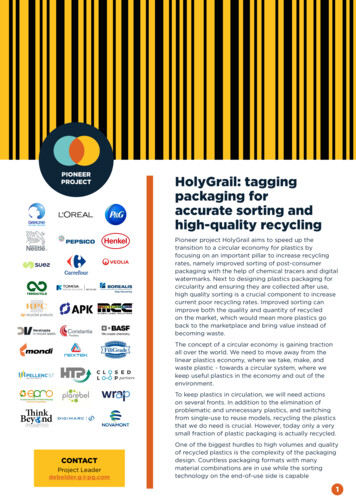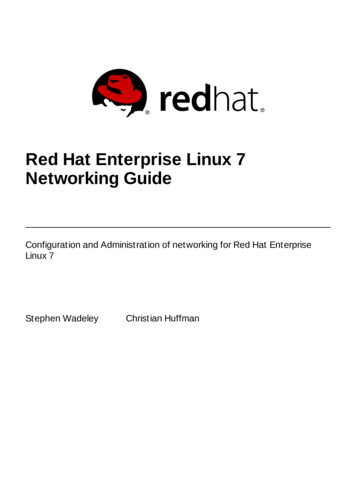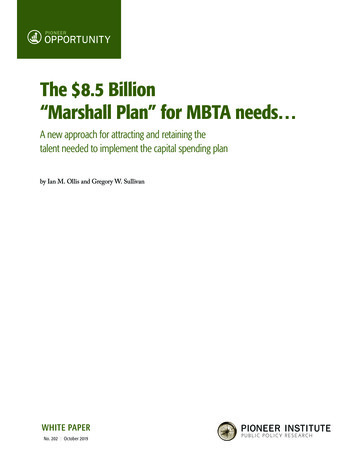
Transcription
PIONEERPROJECTHolyGrail: taggingpackaging foraccurate sorting andhigh-quality recyclingPioneer project HolyGrail aims to speed up thetransition to a circular economy for plastics byfocusing on an important pillar to increase recyclingrates, namely improved sorting of post-consumerpackaging with the help of chemical tracers and digitalwatermarks. Next to designing plastics packaging forcircularity and ensuring they are collected after use,high quality sorting is a crucial component to increasecurrent poor recycling rates. Improved sorting canimprove both the quality and quantity of recycledon the market, which would mean more plastics goback to the marketplace and bring value instead ofbecoming waste.The concept of a circular economy is gaining tractionall over the world. We need to move away from thelinear plastics economy, where we take, make, andwaste plastic - towards a circular system, where wekeep useful plastics in the economy and out of theenvironment.To keep plastics in circulation, we will need actionson several fronts. In addition to the elimination ofproblematic and unnecessary plastics, and switchingfrom single-use to reuse models, recycling the plasticsthat we do need is crucial. However, today only a verysmall fraction of plastic packaging is actually recycled.CONTACTProject Leaderdebelder.g@pg.comOne of the biggest hurdles to high volumes and qualityof recycled plastics is the complexity of the packagingdesign. Countless packaging formats with manymaterial combinations are in use while the sortingtechnology on the end-of-use side is capable1
of recognising only a few properties (suchas 3D vs. 2D shapes or different infraredabsorption for different polymers and/orVIS for colour recognition). There are severalexamples where the design of packagingdisrupts the recycling, either by making anitem ‘invisible’ (e.g. black PET trays cannotbe seen by detectors) or leading to falsepositives/negatives (such as the negativesorting of a full-sleeve PET bottle because thesleeve is typically made of a different materialwhich means the PET is not detected).One approach to improve automateddetection and sorting that has received a lotof interest is to ‘tag’ an item with a unique‘code’. There are several ways of doing this.The methods that have received the mostinterest involve chemical tracers and digitalwatermarks. Tagging is accomplished byapplying chemical(s) to the label, sleeveor plastic object (chemical tracers) or byapplying a ‘digital watermark’, which can beprinted on the label (shrink sleeve, in-mouldlabel, paper or other material) or physicallyincorporated as a subtle pattern embossed inthe plastic itself. Pioneer Project HolyGrail wasset up to investigate if such chemical tracersand digital watermarks could provide a reliableand efficient tagging system that couldeventually be deployed on a large scale, andif so how they might contribute to a circulareconomy for plastics.HOW DOES TAGGING WORK?Chemical tracers and digital watermarkstag items use the same basic principle –they introduce a machine-readable codeor identifier into an item. Then, rather thanrelying only on the ability to distinguish oneor several properties of collected items (e.g.shape, density, IR spectrum of the resin,visual identification), detecting and readingthe code provides the sorting system withinformation unique to that item by pointing toa database where that information is stored.The information tells the system in which wayto sort the item (e.g. food grade vs. non-foodgrade) Such information can be updated andexpanded over time, e.g. to allow for changingsorting preferences if an items recyclabilityimproves. The main difference is in how thecode is applied: A chemical tracer is a moleculeembedded in the plastic resin orpackaging component such as a label,acting as a binary ‘code’ as the chemicalis either present or not. The moleculeis detectable due to its spectroscopicproperties (e.g. being fluorescent underUV light). In principle, it is possibleto combine several different tracermolecules, each with unique spectra, toincrease the number of possible codes.Packaging marked with such chemicalscan be identified and sorted usingsorting equipment that is modified withUV lighting. The chemically tagged itemis insensitive to deformation or otherphysical stress which would otherwisereduce the detectability of many items. A digital watermark is an optical codethe size of a postage stamp, applieddirectly within the item’s label artworkor embossed in the mould, usually ina repeatedly-tiled manner. The codeis created by subtly modulating thepixels that make up the design, or byadding micro-topological variations tothe surface of the plastic as a texture- there is no need for added materials.In addition to detection by an addedcamera/processor on a sorting machine,digital watermarks can be detected bybarcode scanners and smartphones, inpractice turning the tagged items intoInternet-of-Things object. The codescan provide a wide range of attributessuch as manufacturer, SKU, type ofplastics used and composition for multilayer objects, food vs non-food usage,etc. The number of available codes isvirtually unlimited, attributes can beadded over time, and false positiveseliminated.There are several intuitive advantages ofchemical tracers and digital watermarks. The technologies enable sorting of muchhigher granularity and quality Retrofitting existing sorting equipmentwith add-on modules for detection ofchemical tracers or digital watermarksis likely less CAPEX intensive thanupgrading recycling facilities with moresophisticated detection technologybased on material properties. The machine-readable codes could alsobe utilised to enable other applicationsthroughout the value chain. Forexample, digital watermarks couldbe used in manufacturing, for fastercheckout in retail applications, and to2
provide information transparency andcommunicate with users. In principle,it could be possible to access data inreal time, and to get accurate actualrecycling figures broken down to formator individual product level. This couldbe used to inform better design choicesto eliminate packaging elements thatcannot be recycled.However, it is important to investigate howthese technologies fit in the broader recyclingecosystem and actually contribute to acircular economy for plastics.Figure 1: Application of chemical tracers and digital watermarksAs seen by thecamera, but no humanrecognizable patternto codeChemical tracers are applied to the shrinklabel or plastic object and can be detectedunder UV lightingDatabase holds product attributes: Manufacturer SKU/Global Trade ItemNumber Composition andpercentage of plastics inlayers Food vs Non-food Other attributes as desiredDigital WatermarkingFor a demonstration, click here.For a demonstration, click here.Methodology and processAt the start of HolyGrail, a small core project team was formed that looked into all availabletechnologies in the market. A handful of chemical tracer programs were studied at that time,but none of them entered the market, likely due to lack of alignment within the full packagingchain on one technology (or several compatible ones). Digital watermarking was a completelynew concept for plastic packaging recycling. The project was motivated by the belief that newsorting technology for plastic packaging truly requires first cross-value chain alignment onwhich technologies to use, so that they ultimately would become the “barcode of recycling”,before market introduction can take place.The project team started with organizing a public workshop (2017) to accelerate interest inthe topic, which with over 85 participants was a real success. Some key items (that 99% ofparticipants agreed to) were identified:i.the packaging industry needs a non-permanent technology (to minimize the risk ofcross contamination in the next cycle);ii.preferably the selected technology is compatible with existing sorting assets (e.g.allowing easy retrofit of existing sorting units with add-on modules),iii. the technology causes no issues with food safety (such as migration risks); andiv. this “additional dimension in sorting” can solve the top 5 needs identified by theparticipants: 1. distinguish food from non-food (not possible with classical NIR/VISsorters), 2. divert easily compostable packaging from Material Recovery Facilities,3. proper identification of all kinds of full-body sleeved (PET) bottles, 4. Allow newmaterial introductions by proper control of their after-use material flow (no risk ofpolluting established streams), and 5. crack the challenge on multi-layer/materialcomponents (film, tray, bottles ).3
A key focus of the group has been on evaluating the potential of digital watermarks, given thisnew technology can provide benefits across the full value chain in addition to sorting (QA andinventory management at fillers, consumer engagement including anti-counterfeit, fast checkouts at retailers and packaging transparency at end-of-use, e.g. code info for high qualitysorting). Proof-of-concept trials with digital watermarks both in printed materials, as well ascodes directly embedded in the plastic mould, have been studied and a comparison is madewith best-in-class tracer technology PRISM, which was already in development prior the startof HolyGrail and which has continued developing, resulting in high yields/purity proven in fullscale industrial trials at the end of the project in 2018.Since its initiation in early 2017, project HolyGrail has received a lot of traction from bothindustry and local and EU governments, in addition to associations (like Petcore Europe, PCEP,Plastic Recyclers Europe to name a few).Further information on methodology (and most up-to-date technical results/implementationapproaches) is available in the external presentation deck “Pioneer Project HolyGrail: Globalproject on Markers and Digital Watermarks to promote sustainable management of plastic(packaging) waste” which can be acquired upon request by writing to the project leader(email: debelder.g@pg.com) or attending one of the conferences where this projectis featured.RESULTS TO DATE1Project HolyGrail has focused on 2 keyactivities since it was set up in late 2016.1. Compile an overview of the existingtechnology and ensure that thediscussion has input from the entirevalue chain.2. Conduct real tests and small-scalepilots with the most promising codingtechnologies to establish a proof ofconcept.1. Broad value chain engagement hasbeen securedParticipation in HolyGrail has grownsignificantly since its initiation and nowincludes stakeholders from the entire valuechain (including firms and organisations fromoutside the New Plastics Economy participantgroup [see below]). This is key to determininghow to use chemical tracer and digitalwatermarking technology in practice, sincethe whole value chain would need to agreeon a number of principles as well as technicalstandards. The project group notably includesleading machine vendors Tomra and Pellenc,digital watermarking pioneer Digimarc andFiliGrade, a Digimarc licensee, as well asmaterial producers, packaging manufacturers,brands, retailers and recyclers.2. Basic proof of concept has beenestablishedFor chemical tracers, the UK-funded projectcalled PRISM was started in 2016. PRISM hasbeen led by Nextek which is also part of theHolyGrail participant group and concludedin 2018. It showed encouraging results for itspilot system to sort food grade plastics fromnon-food grade plastics. Sorting of full-sleevePET bottles tagged with fluorescent tracersdetected using a UV lamp resulted in highaccuracy and yields at industrial speed.The PRISM proof of concept is an importantbenchmark for digital watermarks. However,digital watermark testing started later and isin an earlier stage of evaluation. The projectgroup has conducted testing to understandapplicability of sorting of different packagingformats (e.g. food vs. non-food grade, darktrays, multi-layer structures, full-body sleevedbottles, flexible plastics, etc.) using digitalwatermarks in the label or the mould itself.The preliminary tests, are so far encouraging,showing that digital watermark technologyworks in several different applications, inaddition to sorting food-grade and non-foodgrade, and can be retrofitted into sortingfacilities. A final round of tests within thecurrent scope of the project is plannedto conclude at end of May 2019, wherewatermark-enhanced plastics items mixedwith true waste will be conducted.1. As a complement to this report, the project group will produce a technical review which includes a more comprehensivetechnology review as well as a potential business model description. As the technology space is rapidly evolving, thetechnology review might also consider other options as they evolve, such as recognition-based sorting enabled byrobotics and machine learning.4
NEXT STEPSDespite having made a lot of progress in the2 years since Pioneer Project HolyGrail wasinitiated, much work remains to be done tounderstand how resin-independent codescould be used at scale. Aside from proving thetechnologies’ robustness and actual valueadding potential, stakeholders need to agreeon a common identification scheme in orderto make it possible to implement codes asa basis for sorting at scale, with one optionpossibly being GS1-derived product attributes.Another open question is data ownership,how to finance the still significant investmentsrequired to retrofit machinery in recyclingfacilities. Project HolyGrail demonstrates thatthe science and invention aspects necessaryfor improved sorting are already in place, andthe engineering and development aspectsnow need to be addressed.For these reasons, a key remaining activityis to disseminate the findings of the projectin the full value chain and engage morestakeholders in order to enable a potentialroll-out of digital watermark/chemical tracertechnology for plastic packaging. To take thetechnology further, a good next step would bea cross value chain pilot on a selected sortingtechnology in an industrial Material RecoveryFacility. This could be conducted as a privatepartnership or partially EU- or regionallyfunded initiative.CONTRIBUTORS TO PIONEER PROJECT HOLYGRAILPioneer Project HolyGrail was led by Procter & Gamble and facilitated by the Ellen MacArthur Foundation.The participant group consisted of representatives from the full packaging value chain, covering Brandowners, waste manufacturers, resin producers and converters, retailers, technology providers/consultantsand investors.WHAT ARE PIONEER PROJECTS?Today’s plastics system faces challenges that no organisation can addressalone. Pioneer Projects are pre-competitive collaborations that are led and runby participants of the New Plastics Economy initiative. They invite stakeholdersfrom across the plastics value chain to design and test innovations that couldchange the way we make, use and reuse plastics.PIONEERPROJECTThe New Plastics Economy Initiative is led by the Ellen MacArthur Foundation.The Foundation works with business, government and academia to build aframework for an economy that is restorative and regenerative by design.The Ellen MacArthur Foundation is not to be held responsible for any outputfrom the Pioneer Projects. It focuses only on facilitating the setup andengaging in the process, and on encouraging circular economy thinking andthe application of a systems perspective.5
small fraction of plastic packaging is actually recycled. One of the biggest hurdles to high volumes and quality of recycled plastics is the complexity of the packaging design. Countless packaging formats with many material combinations are in use while the sorting technology on the end-of-use side is capable PIONEER PROJECT CONTACT Project Leader

![Z W ] } v ] ( ( nce completed, W ] } v W l P ] v P t r õ W ] } v W l P .](/img/56/pioneer-new-client-welcome-2021.jpg)








